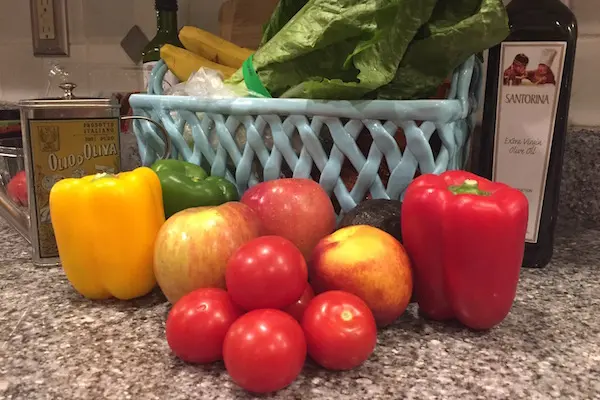Research Says Mediterranean Diet is Best

02/07/2017
By Lauren Carter
Gluten-free, paleo, probiotics, juicing, smoothies, fat is bad, no-fat foods are good, kale!
Hip new diets, trendy supplements and ever-changing rules about what not to eat are the norm in the world of nutrition. With all of the information available — and all of the conflicting claims — t can be difficult to determine what’s actually healthy and what’s just hype.
So we asked Katherine Tucker, professor of nutritional epidemiology in the Biomedical and Nutritional Sciences Department, to weigh in on what new nutrition trends we can expect, which diet is actually the healthiest to follow and whether kale will still rule the day in 2017. Here’s what she had to say:
1. Probiotics and prebiotics will be the talk of 2017.
In the new year, it’s all about good bacteria. These tiny organisms play a big role in our overall health, and Tucker said a major focus of the coming year will be increasing their ranks through probiotics — food or supplements containing live bacteria — and prebiotics, which feed good bacteria and help them grow.
“Probably the biggest thing for nutrition in 2017 will be the microbiome and the use of prebiotics and probiotics,” Tucker said.
Probiotics can be found in foods like yogurt, sauerkraut and kimchi, while prebiotics are found primarily in resistant starch, which is in whole grains, nuts, seeds, legumes and potatoes that have been cooked and cooled, as in potato salad.
“This is yet another reason why these foods, which are virtually missing in many people’s diets—particularly those on the low-carb diet—are so important,” Tucker said. Both probiotics and prebiotics can also be found in supplements, but Tucker said it’s best to eat the foods themselves.
2. Go Mediterranean in 2017.
New year, new you? It wouldn’t be the start of a new year without resolutions to finally lose that extra weight and get in shape once and for all. For those in search of an eating plan that’s based on sound principles and sustainable beyond January, Tucker said Mediterranean is the way to go.
“The Mediterranean diet is the pattern that has shown the most health benefits in research,” Tucker said. “This means increasing the use of olive oil, nuts and seeds, seafood, fruit and vegetables, and fluid dairy such as milk and yogurt while avoiding processed meat, refined-grain products and sugar-sweetened beverages.”
3. Quinoa will give kale a run for its money.
Kale has become the go-to addition to salads, smoothies, pasta dishes, soups and even chips for health-conscious eaters — and for good reason. The dark, leafy green vegetable is loaded with vitamins and minerals. But while kale’s popularity isn’t likely to fade anytime soon, Tucker said quinoa’s star should continue to rise in 2017 and beyond.
“I think quinoa will continue to expand,” Tucker said. “It is the seed of a grain plant, used as a whole grain, that is high in protein, good quality fatty acids, dietary fiber, magnesium, B vitamins and antioxidants and it tastes good.”
Still, Tucker cautioned against relying too heavily on one particular food for a nutritional boost, noting that while foods like kale and quinoa should be part of everyone’s diet, no single food can supply all of a person’s needs, and an overemphasis on any single aspect of nutrition leads to imbalance.
“It seems that people look for a simple solution when it comes to nutrition and then tend to go too far with it, be it low-fat or low-carb diets, supplements or kale,” Tucker said. “It really is all about a variety of good, quality whole foods and balance.”
4. Extremes are out, and balance is in.
“In 2017, I see a decline in the appeal of fad diets,” Tucker said. “People are realizing that while some lead to weight loss at first, they’re not sustainable, and the weight comes back on. There’s also an increasing awareness that broad categories of foods, like fat, aren’t good or bad, but rather it’s the quality of the food and the balance of the overall diet that matters.”
When it comes to imbalance in the typical American diet, Tucker pointed to the following areas:
- Too much animal fat and protein and not enough high-quality plant oils and plant-based proteins, including olive oil, nuts, seeds and beans.
- Too much saturated fat and linoleic acid from meat and refined vegetable oils, and not enough omega-3 fatty acids from fatty fish, walnuts or flaxseeds.
- Too much sodium from processed foods and salty snacks and too little potassium from fruits and vegetables.
- Too much phosphorus from additives in processed foods and too little calcium from high-quality dairy foods like milk and yogurt (tofu and fortified soy milk are alternatives for vegetarians), which may contribute to osteoporosis and stress on the kidneys.
- Too much sugar from soda, juice and sweet baked products.
- Too much carbohydrate intake from refined bread products, including white bread and bagels, and not enough whole grains like brown rice, whole wheat bread and grains like bulgur, kamut and others that are appearing on the market.
- Too little fiber from whole grains, beans, nuts and seeds, fruit and vegetables.
Overall, Tucker said she believes people will continue to move away from processed foods and highly specialized diets to more natural, balanced options in 2017 as priorities shift from short-term weight loss to long-term health.
“I’m optimistic that people are realizing that real, whole foods are the key to health and that there will be a decline in demand for foods that are highly processed with artificial ingredients,” Tucker said. “This is important in supporting local agriculture and sending a message to the food industry that we want minimally processed foods to improve our health.”
